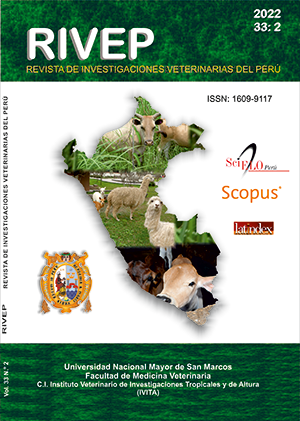Effects of marigold flower (Tagetes erecta) and turmeric rhizome (Curcuma longa) as sources of carotenoid on productive performance and carcass characteristics of dual-purpose chickens in the finishing phase
DOI:
https://doi.org/10.15381/rivep.v33i2.22590Keywords:
dual purpose chicken, carotenoid sources, marigold, turmeric, productive performance, carcass characteristicsAbstract
The aim of this study was to determine the effect of marigold flower (Tagetes erecta) and turmeric rhizome (Curcuma longa) as sources of carotenoids on the productive performance of dual-purpose chicken and carcass characteristics. In total, 120 chickens of both sexes from 84 to 112 days of age were assigned to six treatments (five repetitions per treatment and four birds per repetition), under factorial arrangement with two factors: sex (males and females) and sources of carotenoids (control, marigold and turmeric). All birds received the same concentrated feed, and the differences were the sources of carotenoids. Marigold flower and turmeric rhizome did not improve the productive performance of chickens, nor did they generate adverse effects on growth. Turmeric produced a greater reddish hue in the carcass than marigold; however, the marigold flower caused greater yellowing of the breast skin. Turmeric rhizome reduced the accumulation of abdominal fat in the carcass, with lower liver mass in relation to the bird’s body weight.
Downloads
Downloads
Published
Issue
Section
License
Copyright (c) 2022 Manuel Paredes, Keiko Quispe

This work is licensed under a Creative Commons Attribution 4.0 International License.
AUTHORS RETAIN THEIR RIGHTS:
a. Authors retain their trade mark rights and patent, and also on any process or procedure described in the article.
b. Authors retain their right to share, copy, distribute, perform and publicly communicate their article (eg, to place their article in an institutional repository or publish it in a book), with an acknowledgment of its initial publication in the Revista de Investigaciones Veterinarias del Perú (RIVEP).
c. Authors retain theirs right to make a subsequent publication of their work, to use the article or any part thereof (eg a compilation of his papers, lecture notes, thesis, or a book), always indicating the source of publication (the originator of the work, journal, volume, number and date).










